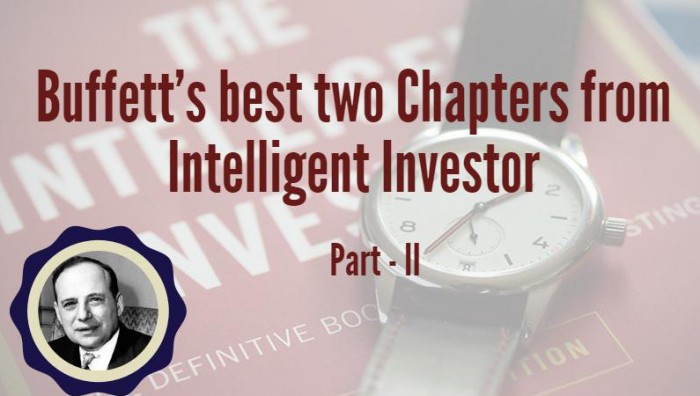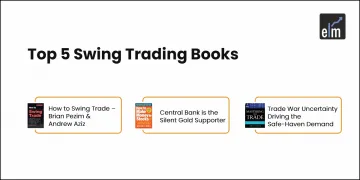Chapter 20 discusses the concept of Margin of safety.
It protects the investor against any loss in case of any decline in share price.
This concept has been the bedrock of Benjamin Graham’s successful investing journey.
Some of the important lessons from Chapter 20 of “Intelligent Investor” is stated below:-
1. Concept of ‘Margin of Safety’
The Margin of Safety is the difference between the percentage rate of the earnings on the stock at the price you pay for it and rate of interest on bonds.
Say the earnings from the market is over 10% YoY while the interest on bonds is 4%, so there is a margin of safety over more than 100%.
Graham said, “Over a ten-year period the typical excess of stock earning power over bond interest may aggregate 50% of price paid. This figure is sufficient to provide a very real margin of safety which under favourable conditions, will prevent or minimize a loss”
Graham believes that in order to judge the earnings power of a company, it’s important to check that how the company performed during the bad times and not only 2-3 years of a good period.
The margin of safety depends upon the price you paid for the stock. It will be large at one price, small at some higher price, nonexistent at some still higher price.
Graham said, “Imagine that you find a stock that you think can grow at 10% a year even if the market only grows 5% annually. Unfortunately, you are so enthusiastic that you pay too high a price, and the stock loses 50% of its value the first year. Even if the stock generates double the market’s return, it will take you more than 16 years to overtake the market-simply because you paid too much, and lost too much, at the outset”
2. Correlation between the margin of safety and theory of diversification–
There is a close connection between the margin of safety and principle of diversification.
Even with a margin of safety in favor of investor, a stock may work out badly.
Since 100% margin of safety cannot guarantee profit for an individual stock, hence there should be a diversification in the stock portfolio.
Diversification implies buying stocks of more than one company thus reducing the risk from an individual stock.
3. Graham on the valuation of stocks
Graham believes that there is no such thing as good or bad stock.
There are only cheap stocks and expensive stocks.
Even the best company becomes a “sell” when its stock price goes too high, while the worst company is worth buying if its stock price goes low enough.
Graham said, “The very people who considered technology and telecommunications stock a ‘sure thing’ in late 1999 and early 2000, when they were hellishly overpriced, shunned them as “too risky” in 2002- even though, in Graham’s exact words from an earlier period, ‘the price depreciation of about 90% made many of these securities exceedingly attractive and reasonably safe’. Similarly, Wall street’s analysts have always tended to call a stock a ‘strong buy’ when its price is high, and to label it a ‘sell’ after its price has fallen- the exact opposite of what Graham would dictate”
Want to know more about Ben Graham ‘s style of investing? Enroll in: NSE Academy Certified Equity Research Analysis course on Elearnmarkets.
4. Invest in your circle of competence
Investment is most intelligent when it is more businesslike.
Ben Graham discussed four main principles of this concept which are discussed below:-
a. The first principle says, “Know what you are doing- know your business”
b. Second principle says, “Do not let anyone else run your business unless (1) you can supervise his performance with adequate care and comprehension or (2) you have unusually strong reasons for placing implicit confidence in his integrity and ability”
c. The third principle says, “Do not enter upon an operation- that is, manufacturing or trading in an item- unless a reliable calculation shows that it has a fair chance to yield a reasonable profit. In particular, keep away from ventures in which you have little to gain and much to lose”
d. Final principle says, “Have the courage of your knowledge and experience. If you have formed a conclusion from the facts and if you know your judgement is sound, act on it- even though others may hesitate or differ”
5. Definition of risk
Ben Graham said, “In 1999, risk didn’t mean losing money; it meant making less money than someone else. What many people feared was bumping into somebody at a barbecue who was getting even richer even quicker by day trading dot-com stocks than they were. Then, quite suddenly, by 2003 risk had come to mean that the stock market might keep dropping until it wiped out whatever traces of wealth you still had left”
The people attained the biggest gain who took a bigger bet in the bull market but the same people got hurt the worst in the bear phase.
Graham said, “Being right makes speculator even more eager to take extra risk, as their confidence catches fire”.
And once you are hit with a bigger loss, you have to gamble even harder to reach the position where you initially were.
Graham said, “Like a racetrack or casino gambler who desperately doubles up after every bad bet. Unless you are phenomenally lucky, that’s a recipe for disaster”
Losing money is a part and parcel of investing and you can’t do anything to prevent it.
But as an intelligent investor, you should ensure that you never lose most or all of your money.
Read More: How “risky” is risk?
6. Two lessons from Daniel Kahneman–
The Nobel prize-winning psychologist, Daniel Kahneman explains two factors which help in making good decisions stated below-
a. “Well calibrated confidence” (do I understand this investment as well as I think I do?)
b. “Correctly-anticipated regret” (how will I react if my analysis turns out to be wrong?)
Bottomline
I believe investing is all about discipline.
The more early you start, you will be able to reap most of the gains.
It’s important to gain some knowledge on the way and there can be no better book on investing than Intelligent Investor.
I’ll ask everyone to read this book and reread it to gain more wisdom.







I’m impressed, I need to say. Actually not often do I encounter a blog that’s both educative and entertaining, and let me tell you, you might have hit the nail on the head. Your thought is excellent; the issue is something that not enough individuals are speaking intelligently about. I am very glad that I stumbled across this in my search for something referring to this.